Characterization of Two Potential Biocontrol Bacillus Strains Against Maize Stalk Rot
Abstract
1. Introduction
2. Materials and Methods
2.1. Plant and Fungal Materials
2.2. Isolation and In Vitro Antagonistic Activity of Bacterial Strains Against F. graminearum
2.3. Plant-Growth-Promoting Assays of KP3P9 and K13C on Maize Seedlings
2.4. The Biocontrol Activity Analysis of KP3P9 and K13C Against MSR in Maize Seedlings
2.5. Molecular Characterization of KP3P9 and K13C
2.6. Physiological and Biochemical Characterization of B. subtilis KP3P9 and B. siamensis K13C
2.7. Phosphate-Solubilizing and Potassium Release Capacity Analysis of KP3P9 and K13C
2.8. Indole-3-Acetic Acid (IAA)-Producing Capacity Analysis of KP3P9 and K13C
2.9. Determinations of Cellulase, Protease, β-1,3-Glucanase and Siderophore-Producing Activities
2.10. Genome Sequencing and Assembly
2.11. Antagonistic Activity of the Two Bacillus Strains Against Other Fusarium Pathogens
2.12. Statistical Analysis
3. Results
3.1. Morphological, Physiological and Biochemical Characteristics of KP3P9 and K13C
3.2. Antagonistic Activity of KP3P9 and K13C Against F. graminearum
3.3. Effects of KP3P9 and K13C on the Growth of Maize Seedlings
3.4. Influences of KP3P9 and K13C on the MSR Resistance of Maize Seedlings
3.5. Molecular Identification of KP3P9 and K13C
3.6. Genome Assembly and Annotation Results of KP3P9 and K13C, and Prediction Results of Biosynthetic Gene Clusters
3.7. Potential Antimicrobial Substrances Detection Results
3.8. The Antagonistic Ability of KP3P9 and K13C Against Other Fusarium Species
4. Discussion
5. Conclusions
Supplementary Materials
Author Contributions
Funding
Institutional Review Board Statement
Informed Consent Statement
Data Availability Statement
Conflicts of Interest
Abbreviations
| BGC | Biosynthetic gene clusters |
| CRISPR | Clustered regularly interspaced short palindromic repeats |
| DSI | Disease severity index |
| Foc1 | F. oxysporum f. sp. cubense race 1 |
| FocTR4 | F. oxysporum f. sp. cubense tropical race 4 |
| Fs | F. solani |
| IAA | Indole-3-acetic acid |
| LB | Lysogeny broth |
| MSR | Maize stalk rot |
| PDA | Potato dextrose agar |
| PGP | Plant-growth-promoting |
| Rs | Rhizoctonia solani |
References
- Yuan, Y.; Zhang, S.; Tan, X.; Deng, J.; Gong, S.; Zhai, X.; Xu, X.; Ruan, C.; Hu, Y.; Zhang, J.; et al. Intestinal bacterium Bacillus siamensis M54 from Allomyrina dichotoma is a potential biocontrol agent against maize stalk rot. Biol. Control 2024, 199, 105660. [Google Scholar] [CrossRef]
- Cao, Y.; Ma, J.; Han, S.; Hou, M.; Wei, X.; Zhang, X.; Zhang, Z.; Sun, S.; Ku, L.; Tang, J.; et al. Single-cell RNA sequencing profiles reveal cell type-specific transcriptional regulation networks conditioning fungal invasion in maize roots. Plant Biotechnol. J. 2023, 21, 1839–1859. [Google Scholar] [CrossRef] [PubMed]
- Wang, L.; Jia, J.; Su, Q.; Cao, H.; Jia, S.; Si, H.; Cao, Z.; Ma, S.; Xing, J.; Zhang, K.; et al. Root-associated microbial diversity and metabolomics in maize resistance to stalk rot. Front. Microbiol. 2024, 15, 1468627. [Google Scholar] [CrossRef]
- Asiedu, D.D.; Miedaner, T. Genetic and genomic tools in breeding for resistance to Fusarium stalk rot in maize (Zea mays L.). Plants 2025, 14, 819. [Google Scholar] [CrossRef]
- Gai, X.T.; Xuan, Y.H.; Gao, Z.G. Diversity and pathogenicity of Fusarium graminearum species complex from maize stalk and ear rot strains in North-East China. Plant Pathol. 2017, 66, 1267–1275. [Google Scholar] [CrossRef]
- Figueroa-López, A.; Cordero-Ramírez, J.; Martínez-Álvarez, J.; López-Meyer, M.; Lizárraga-Sánchez, G.; Félix-Gastélum, R.; Castro-Martínez, C.; Maldonado-Mendoza, L. Rhizospheric bacteria of maize with potential for biocontrol of Fusarium verticillioides. SpringerPlus 2016, 5, 330. [Google Scholar] [CrossRef]
- Zhang, X.; Zheng, S.; Yu, M.; Xu, C.; Li, Y.; Sun, L.; Hu, G.; Yang, J.; Qiu, X. Evaluation of resistance resources and analysis of resistance mechanisms of maize to stalk rot caused by Fusarium graminearum. Plant Dis. 2024, 108, 348–358. [Google Scholar] [CrossRef]
- Han, S.; Cao, Y.; Zhang, J.; Wang, J.; Zhang, L.; Chen, Y.; Ku, L.; Duan, C. First report of Fusarium cf. longipes associated with Maize stalk rot in China. Plant Dis. 2022, 106, 1064. [Google Scholar] [CrossRef]
- Shin, J.; Han, J.; Lee, J.; Kim, K. Characterization of the maize stalk rot pathogens Fusarium subglutinans and F. temperatum and the effect of fungicides on their mycelial growth and colony formation. Plant Pathol. J. 2014, 30, 397–406. [Google Scholar] [CrossRef] [PubMed]
- Sun, X.; Yang, R.; Tang, H.; Ma, M.; Chen, H.; Chang, X.; Zhang, M.; Gong, G. Diversity and pathogenicity of Fusarium species associated with stalk and crown rot in maize in northern Italy. Sci. Rep. 2025, 15, 5984. [Google Scholar]
- Xi, K.; Shan, L.; Yang, Y.; Zhang, G.; Zhang, J.; Guo, W. Species diversity and chemotypes of Fusarium species associated with maize stalk rot in Yunnan province of southwest China. Front. Microbiol. 2021, 12, 652062. [Google Scholar] [CrossRef]
- Jia, S.; Liu, Y.; Wang, Z.; Zang, J.; Zhang, K.; Dong, J.; Si, H.; Xing, J. Screening and identification of a biocontrol strain against maize stalk rot and evaluation of its field control effect. Microbiol. China 2025, 52, 3111–3123. [Google Scholar]
- Bonaterra, A.; Badosa, E.; Daranas, N.; Francés, J.; Roselló, G.; Montesinos, E. Bacteria as biological control agents of plant diseases. Microorganisms 2022, 10, 1759. [Google Scholar] [CrossRef]
- Singh, S.; Shyu, D. Perspective on utilization of Bacillus species as plant probiotics for different crops in adverse conditions. AIMS Microbiol. 2024, 10, 220–238. [Google Scholar] [CrossRef] [PubMed]
- Xia, X.; Wei, Q.; Wu, H.; Chen, X.; Xiao, C.; Ye, Y.; Liu, C.; Yu, H.; Guo, Y.; Sun, W.; et al. Bacillus species are core microbiota of resistant maize cultivars that induce host metabolic defense against corn stalk rot. Microbiome 2024, 12, 156. [Google Scholar] [CrossRef]
- Zhang, K.; Wang, L.; Si, H.; Guo, H.; Liu, J.; Jia, J.; Su, Q.; Wang, Y.; Zang, J.; Xing, J.; et al. Maize stalk rot caused by Fusarium graminearum alters soil microbial composition and is directly inhibited by Bacillus siamensis isolated from rhizosphere soil. Front. Microbiol. 2022, 13, 986401. [Google Scholar] [CrossRef]
- Wang, S.; Jin, P.; Zheng, Y.; Wu, K.; Chen, J.; Liu, J.; Li, Y. Bacillus velezensis B105-8, a potential and efficient biocontrol agent in control of maize stalk rot caused by Fusarium graminearum. Front. Microbiol. 2024, 15, 1462992. [Google Scholar] [CrossRef]
- Kim, J.; Song, J.; Kim, P.; Kim, D.; Kim, Y. Bacillus velezensis TSA32-1 as a promising agent for biocontrol of plant pathogenic fungi. J. Fungi 2022, 8, 1053. [Google Scholar] [CrossRef] [PubMed]
- Cheng, X.; Ji, X.; Ge, Y.; Li, J.; Qi, W.; Qiao, K. Characterization of antagonistic Bacillus methylotrophicus isolated from rhizosphere and its biocontrol effects on Maize stalk rot. Phytopathology 2019, 109, 571–581. [Google Scholar] [CrossRef] [PubMed]
- Sun, Y.; Ruan, X.; Ma, L.; Wang, F.; Gao, X. Rapid screening and evaluation of maize seedling resistance to stalk rot caused by Fusarium spp. Bio Protoc. 2018, 8, e2859. [Google Scholar] [CrossRef]
- Dong, X.Z.; Cai, M.Y. Common Bacterial System Identification Manual; Science Press: Beijing, China, 2001. (In Chinese) [Google Scholar]
- Liu, M.; Liu, X.; Cheng, B.; Ma, X.; Lyu, X.; Zhao, X.; Ju, Y.; Zhuo, M.; Zhang, Z.; Fang, Y. Selection and evaluation of phosphate-solubilizing bacteria from grapevine rhizospheres for use as biofertilizers. Span. J. Agric. Res. 2016, 14, e1106. [Google Scholar] [CrossRef]
- Guo, Y.; Tian, L.; Zhu, X.; Liu, S.; Wang, L.; Li, W. Antagonism of Bacillus velezensis ZGE166 against the pathogenic fungi causing corm rot disease in Saffron (Crocus sativus L.). Microb. Ecol. 2025, 88, 40. [Google Scholar] [CrossRef]
- Muthuraja, R.; Muthukumar, T. Isolation and characterization of potassium solubilizing Aspergillus species isolated from saxum habitats and their effect on maize growth in different soil types. Geomicrobiol. J. 2021, 38, 672–685. [Google Scholar] [CrossRef]
- Chowhan, L.; Mir, M.; Sabra, M.; El-Habbab, A.; Kiran, K. Plant growth promoting and antagonistic traits of bacteria isolated from forest soil samples. Iran J. Microbiol. 2023, 15, 278–289. [Google Scholar] [CrossRef] [PubMed]
- Borah, A.; Thakur, D. Phylogenetic and functional characterization of culturable endophytic Actinobacteria associated with Camellia spp. for growth promotion in commercial tea cultivars. Front. Microbiol. 2020, 11, 318. [Google Scholar] [CrossRef]
- Yuan, H.; Yuan, M.; Shi, B.; Wang, Z.; Huang, T.; Zhu, J.; Hou, H.; Wang, L.; Tu, H. Biocontrol activity of Bacillus halotolerans strain Pl7 against Botryosphaeria dothidea causing apple postharvest decay and potential mechanisms. Front. Microbiol. 2023, 13, 1058167. [Google Scholar] [CrossRef] [PubMed]
- Schwyn, B.; Neilands, J. Universal chemical assay for the detection and determination of siderophores. Anal. Biochem. 1987, 160, 47–56. [Google Scholar] [CrossRef] [PubMed]
- Deng, Z.; Wang, J.; Yan, Y.; Wang, J.; Shao, W.; Wu, Z. Biochar-based Bacillus subtilis inoculants promote plant growth: Regulating microbial community to improve soil properties. J. Environ. Manag. 2025, 373, 123534. [Google Scholar] [CrossRef]
- Muhammad, H.; Ijaz, M.; Sattar, A.; Ul-Allah, S.; Sher, A.; Asif, M.; Dilshad, M.; Mahmood, K.; Riaz, M.W.; Zaheer, M.S.; et al. Synergistic effects of PGPRs and fertilizer amendments on improving the yield and productivity of Canola (Brassica napus L.). BMC Plant Biol. 2025, 25, 50. [Google Scholar] [CrossRef]
- Tariq, H.; Subramanian, S.; Geitmann, A.; Smith, D.L. Bacillus and Paenibacillus as plant growth-promoting bacteria in soybean and cannabis. Front. Plant Sci. 2025, 16, 1529859. [Google Scholar] [CrossRef]
- Sui, J.; Yang, J.; Li, C.; Zhang, L.; Hua, X. Effects of a microbial restoration substrate on plant growth and rhizosphere microbial community in a continuous cropping poplar. Microorganisms 2023, 11, 486. [Google Scholar] [CrossRef]
- Dong, W.; Long, T.; Ma, J.; Wu, N.; Mo, W.; Zhou, Z.; Jin, J.; Zhou, H.; Ding, H. Effects of Bacillus velezensis GUAL210 control on edible rose black spot disease and soil fungal community structure. Front. Microbiol. 2023, 14, 1199024. [Google Scholar] [CrossRef] [PubMed]
- Ahmad, A.M.; Attia, A.G.; Mohamed, M.S. Fermentation, formulation and evaluation of PGPR Bacillus subtilis isolate as a bioagent for reducing occurrence of peanut soil-borne diseases. J. Integr. Agric. 2019, 18, 2080–2092. [Google Scholar] [CrossRef]
- Abdelmoteleb, A.; Moreno-Ramírez, L.; Valdez-Salas, B.; Seleiman, M.F.; El-Hendawy, S.; Aldhuwaib, K.J.; Alotaibi, M.; González-Mendoza, D. New Bacillus subtilis strains isolated from Prosopis glandulosa rhizosphere for suppressing Fusarium spp. and enhancing growth of Gossypium hirsutum L. Biology 2022, 12, 73. [Google Scholar] [CrossRef] [PubMed]
- He, H.; Zhai, Q.; Tang, Y.; Gu, X.; Pan, H.; Zhang, H. Effective biocontrol of soybean root rot by a novel bacterial strain Bacillus siamensis HT1. Physiol. Mol. Plant Pathol. 2023, 125, 101984. [Google Scholar] [CrossRef]
- Yang, Y.; Zhang, Y.; Zhang, L.; Zhou, Z.; Zhang, J.; Yang, J.; Gao, X.; Chen, R.; Huang, Z.; Xu, Z.; et al. Isolation of Bacillus siamensis B-612, a strain that is resistant to rice blast disease and an investigation of the mechanisms responsible for suppressing rice blast fungus. Int. J. Mol. Sci. 2023, 24, 8513. [Google Scholar] [CrossRef]
- Deng, Z.; Wang, J.; Yan, Y.; Wang, J.; Shao, W.; Wu, Z. Biochar-based Bacillus subtilis inoculant for enhancing plants disease prevention: Microbiota response and root exudates regulation. Biochar 2023, 5, 81. [Google Scholar] [CrossRef]
- Yang, F.; Wang, X.; Jiang, H.; Yao, Q.; Liang, S.; Chen, W.; Shi, G.; Tian, B.; Hegazy, A.; Ding, S. Mechanism of a novel Bacillus subtilis JNF2 in suppressing Fusarium oxysporum f. sp. cucumerium and enhancing cucumber growth. Front. Microbiol. 2024, 13, 1459906. [Google Scholar] [CrossRef]
- Zhu, J.; Tan, T.; Shen, A.; Yang, X.; Yu, Y.; Gao, C.; Li, Z.; Cheng, Y.; Chen, J.; Guo, L.; et al. Biocontrol potential of Bacillus subtilis IBFCBF-4 against Fusarium wilt of watermelon. J. Plant Pathol. 2020, 102, 433–441. [Google Scholar] [CrossRef]
- Liu, L.; Jin, X.; Lu, X.; Guo, L.; Lu, P.; Yu, H.; Lv, B. Mechanisms of Surfactin from Bacillus subtilis SF1 against Fusarium foetens: A Novel Pathogen Inducing Potato Wilt. J. Fungi 2023, 9, 367. [Google Scholar] [CrossRef]
- Jia, Y.; Huang, J.; Qi, L.; Zhang, X.; Liu, J.; Guan, H.; Wang, C.; Tang, G.; Dou, X.; Lu, M. Bacillus subtilis strain BS06 protects soybean roots from Fusarium oxysporum infection. FEMS Microbiol. Lett. 2021, 368, fnab102. [Google Scholar] [CrossRef]
- Ding, S.; Li, P.; Tang, Y.; He, Z.; She, X. Identification and genomic insights into Bacillus siamensis strains with host colonization potential and activity against tomato bacterial wilt. Pest. Manag. Sci. 2025, 81, 1547–1561. [Google Scholar] [CrossRef] [PubMed]
- Ho, Y.-N.; Hoo, S.Y.; Wang, B.-W.; Hsieh, C.-T.; Lin, C.-C.; Sun, C.-H.; Peng, C.-C.; Yang, Y.-L. Specific inactivation of an antifungal bacterial siderophore by a fungal plant pathogen. ISME J. 2021, 15, 1858–1861. [Google Scholar] [CrossRef]
- Tian, Y.; Ji, S.; Zhang, E.; Chen, Y.; Xu, G.; Chen, X.; Fan, J.; Tang, X. Complete genome analysis of Bacillus subtilis TY-1 reveals its biocontrol potential against tobacco bacterial wilt. Mar. Genom. 2023, 68, 101018. [Google Scholar] [CrossRef]
- Long, Y.; Chen, S.; Xu, X.; Zhao, W.; Tang, X.; Zhang, L.; Zhang, Q. High-quality genome resource of Bacillus subtilis N4, a biological control agent isolated from Phoebe bournei. Phytopathology 2023, 113, 577–579. [Google Scholar] [CrossRef]
- Dong, Q.; Liu, Q.; Goodwin, P.H.; Deng, X.; Xu, W.; Xia, M.; Zhang, J.; Sun, R.; Wu, C.; Wang, Q.; et al. Isolation and genome-based characterization of biocontrol potential of Bacillus siamensis YB-1631 against wheat crown rot caused by Fusarium pseudograminearum. J. Fungi 2023, 9, 547. [Google Scholar] [CrossRef] [PubMed]
- Pan, H.; Tian, X.; Shao, M.; Xie, Y.; Huang, H.; Hu, J.; Ju, J. Genome mining and metabolic profiling illuminate the chemistry driving diverse biological activities of Bacillus siamensis SCSIO 05746. Appl. Microbiol. Biotechnol. 2019, 103, 4153–4165. [Google Scholar] [CrossRef] [PubMed]
- Hanif, A.; Zhang, F.; Li, P.; Li, C.; Xu, Y.; Zubair, M.; Zhang, M.; Jia, D.; Zhao, X.; Liang, J.; et al. Fengycin produced by Bacillus amyloliquefaciens FZB42 inhibits Fusarium graminearum growth and mycotoxins biosynthesis. Toxins 2019, 11, 295. [Google Scholar] [CrossRef]
- Chakraborty, K.; Kizhakkekalam, V.K.; Joy, M.; Chakraborty, R.D. Bacillibactin class of siderophore antibiotics from a marine symbiotic Bacillus as promising antibacterial agents. Appl. Microbiol. Biotechnol. 2022, 106, 329–340. [Google Scholar] [CrossRef]
- Halami, P.M. Sublichenin, a new subtilin-like lantibiotics of probiotic bacterium Bacillus licheniformis MCC 2512T with antibacterial activity. Microb. Pathog. 2019, 128, 139–146. [Google Scholar] [CrossRef]
- Charron-Lamoureux, V.; Haroune, L.; Pomerleau, M.; Hall, L.; Orban, F.; Leroux, J.; Rizzi, A.; Bourassa, J.-S.; Fontaine, N.; D’aStous, É.V.; et al. Pulcherriminic acid modulates iron availability and protects against oxidative stress during microbial interactions. Nat. Commun. 2023, 14, 2536. [Google Scholar] [CrossRef] [PubMed]
- Shelburne, C.E.; An, F.Y.; Dholpe, V.; Ramamoorthy, A.; Lopatin, D.E.; Lantz, M.S. The spectrum of antimicrobial activity of the bacteriocin subtilosin A. J. Antimicrob. Chemoth. 2007, 59, 297–300. [Google Scholar] [CrossRef]
- Islam, T.; Rabbee, M.; Choi, J.; Baek, K.H. Biosynthesis, molecular regulation, and application of bacilysin produced by Bacillus species. Metabolites 2022, 27, 397. [Google Scholar] [CrossRef]
- Chen, L.; Xu, X.; Sun, Y.; Xin, Q.; Lv, Y.; Hu, Y.; Bian, K. Surfactin inhibits Fusarium graminearum by accumulating intracellular ROS and inducing apoptosis mechanisms. World J. Microbiol. Biotechnol. 2023, 39, 340. [Google Scholar] [CrossRef] [PubMed]
- Zhao, Y.; Selvaraj, J.N.; Xing, F.; Zhou, L.; Wang, Y.; Song, H.; Tan, X.; Sun, L.; Sangare, L.; Folly, Y.M.; et al. Antagonistic action of Bacillus subtilis strain SG6 on Fusarium graminearum. PLoS ONE 2014, 9, e92486. [Google Scholar] [CrossRef] [PubMed]
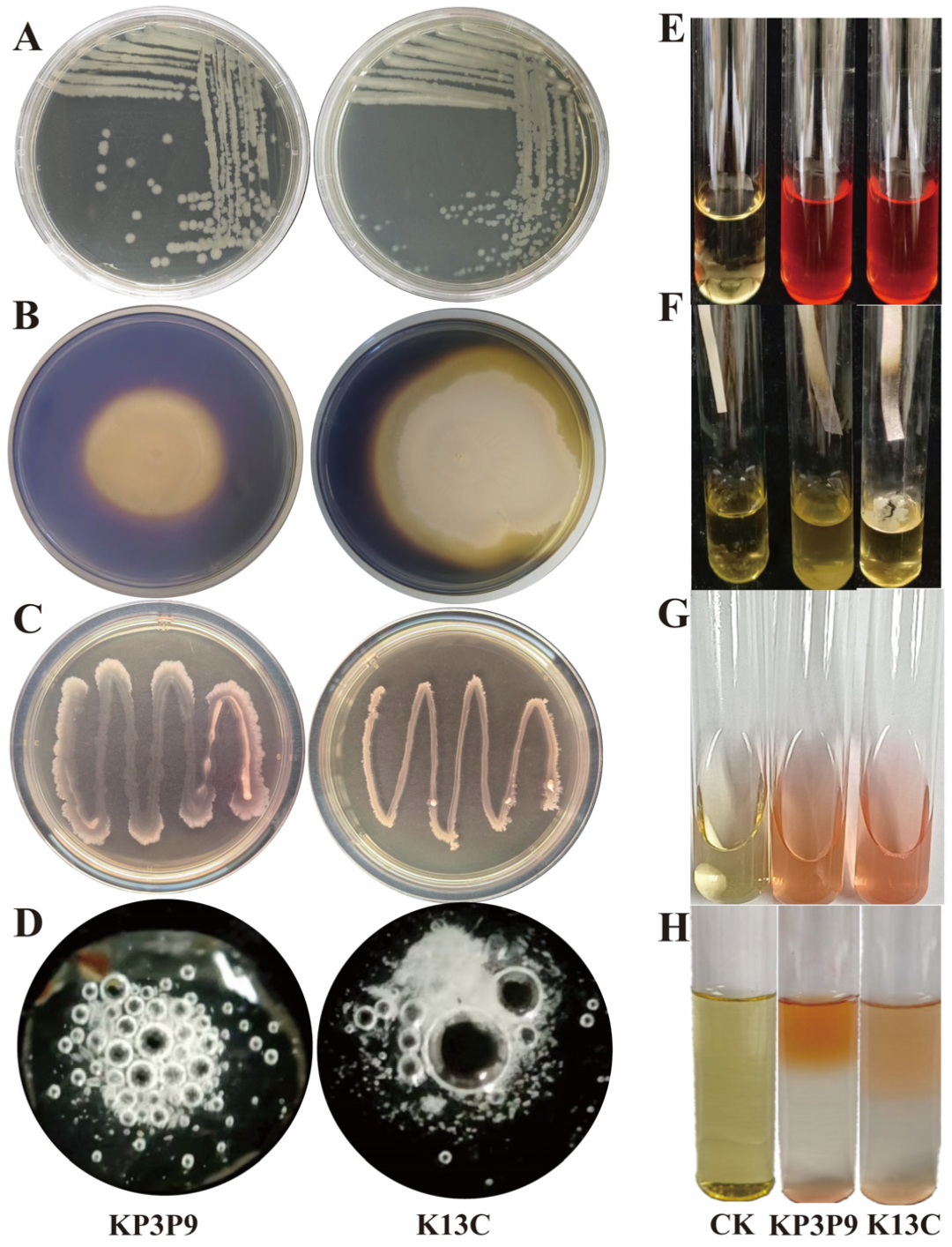
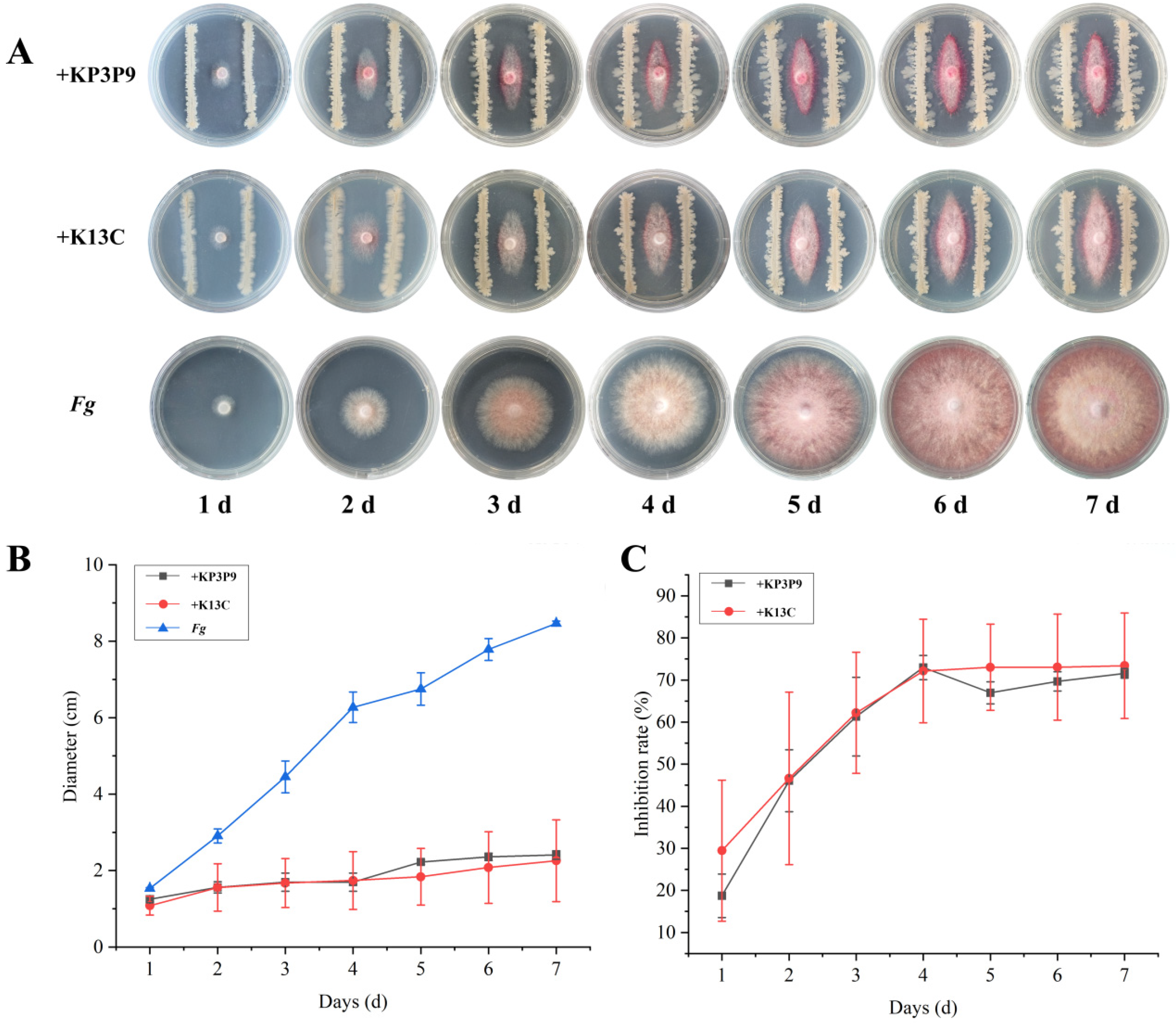
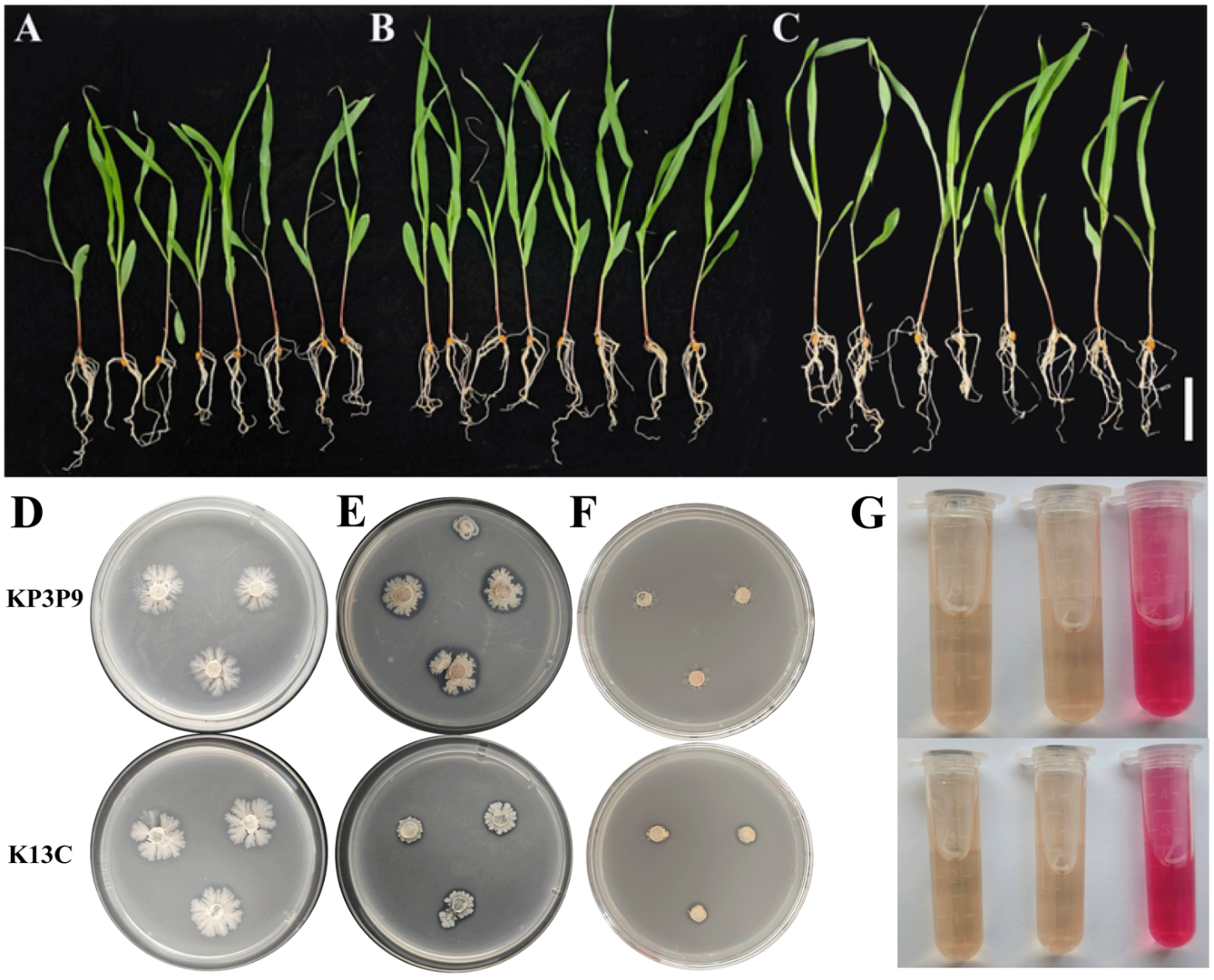
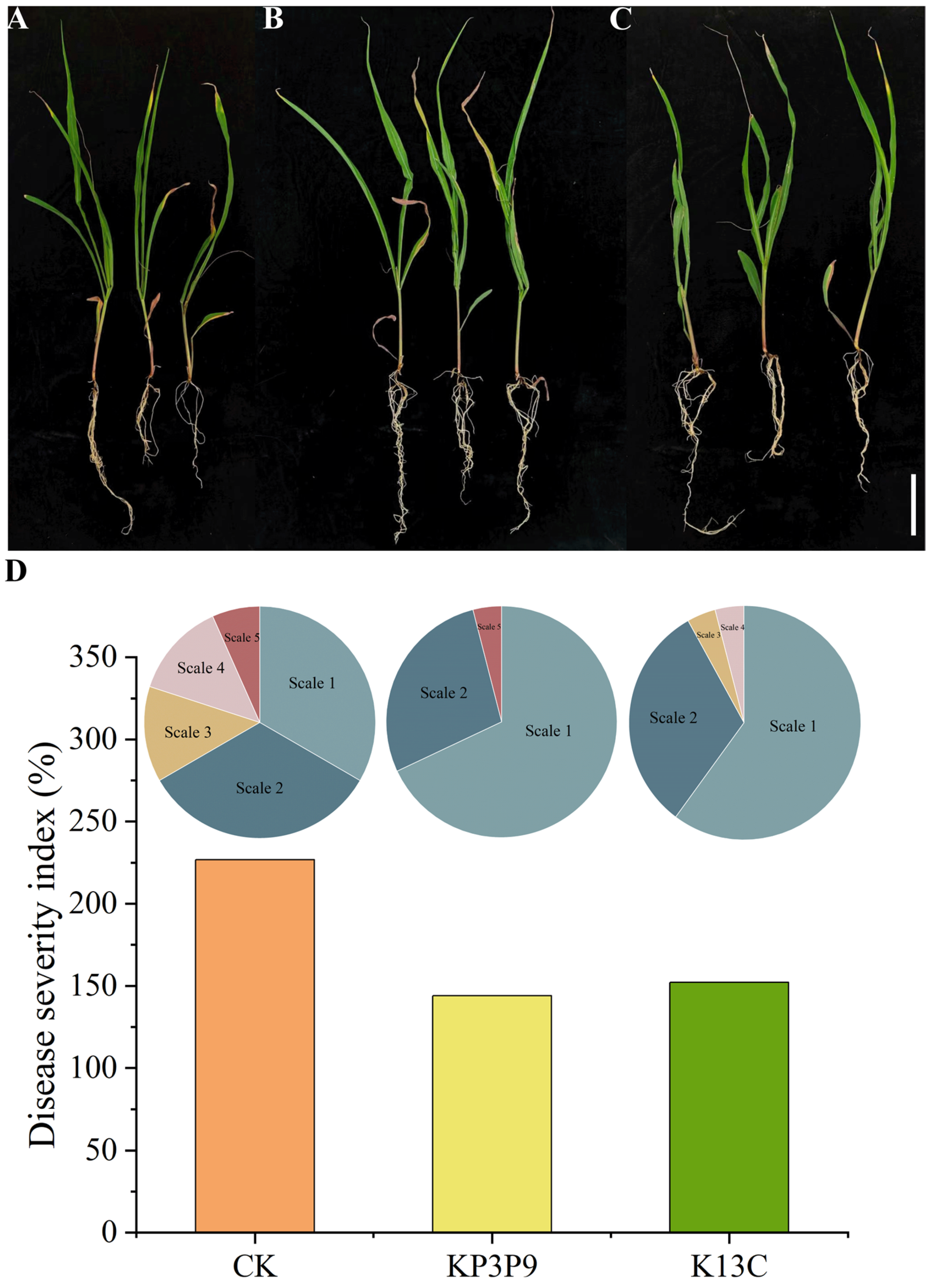
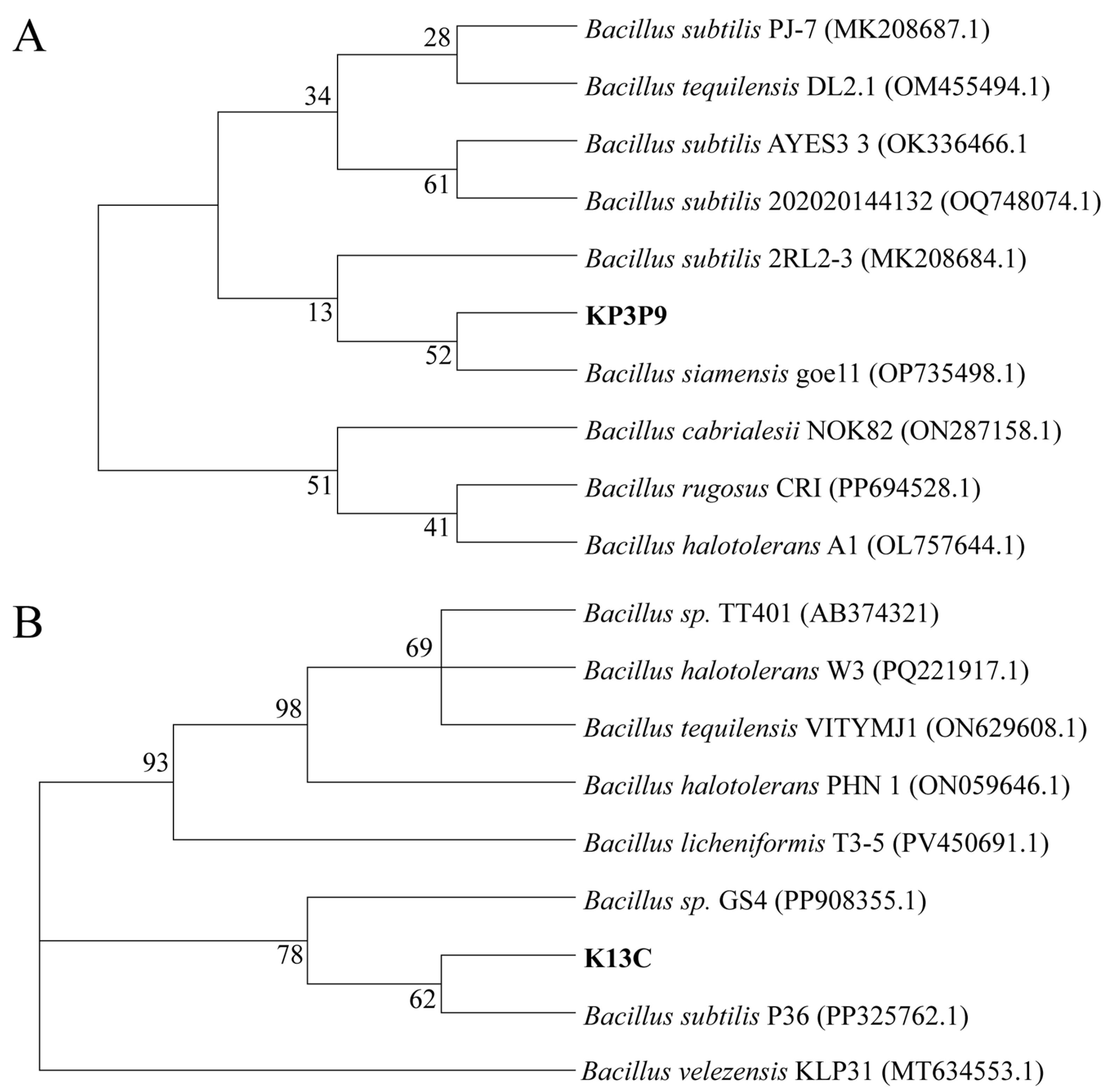
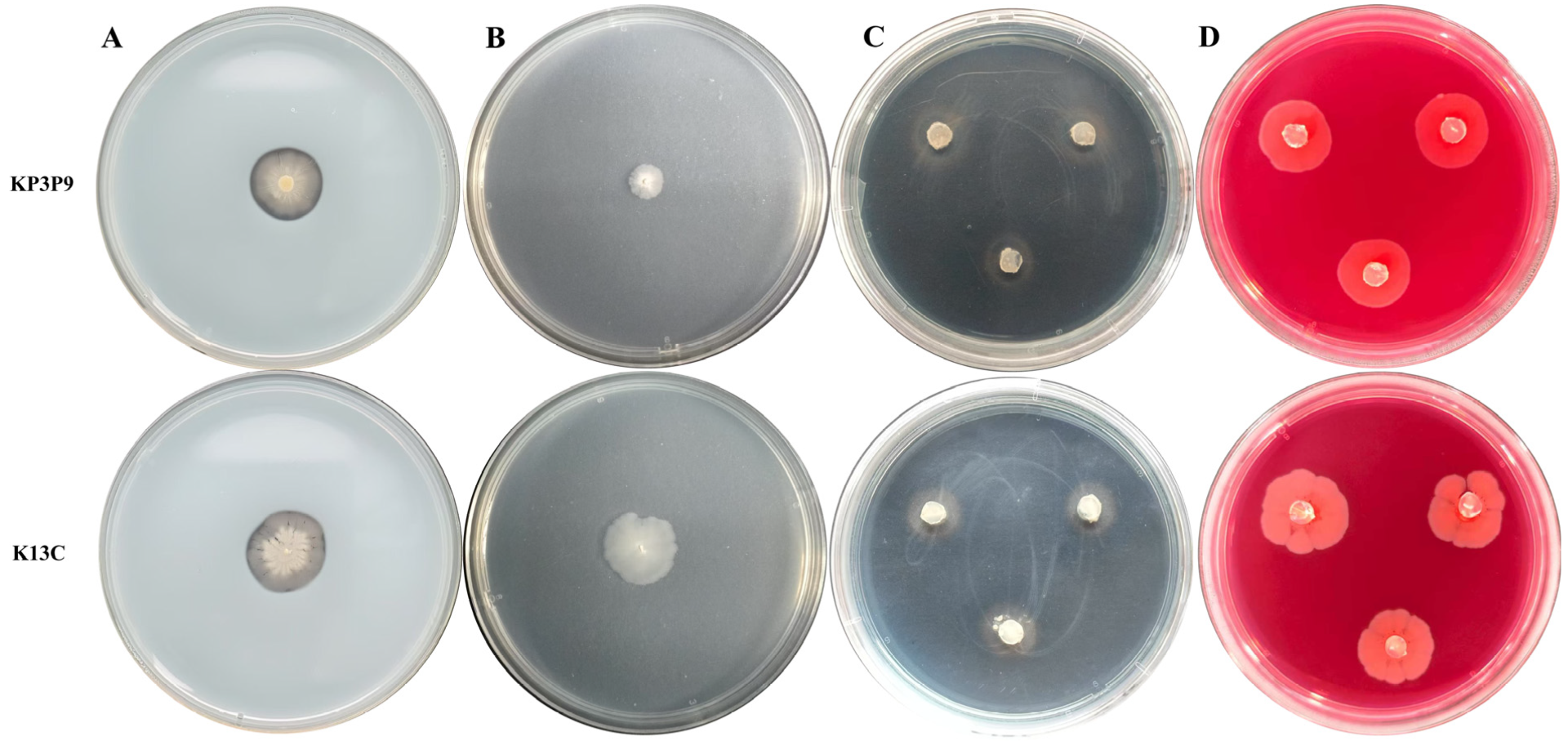
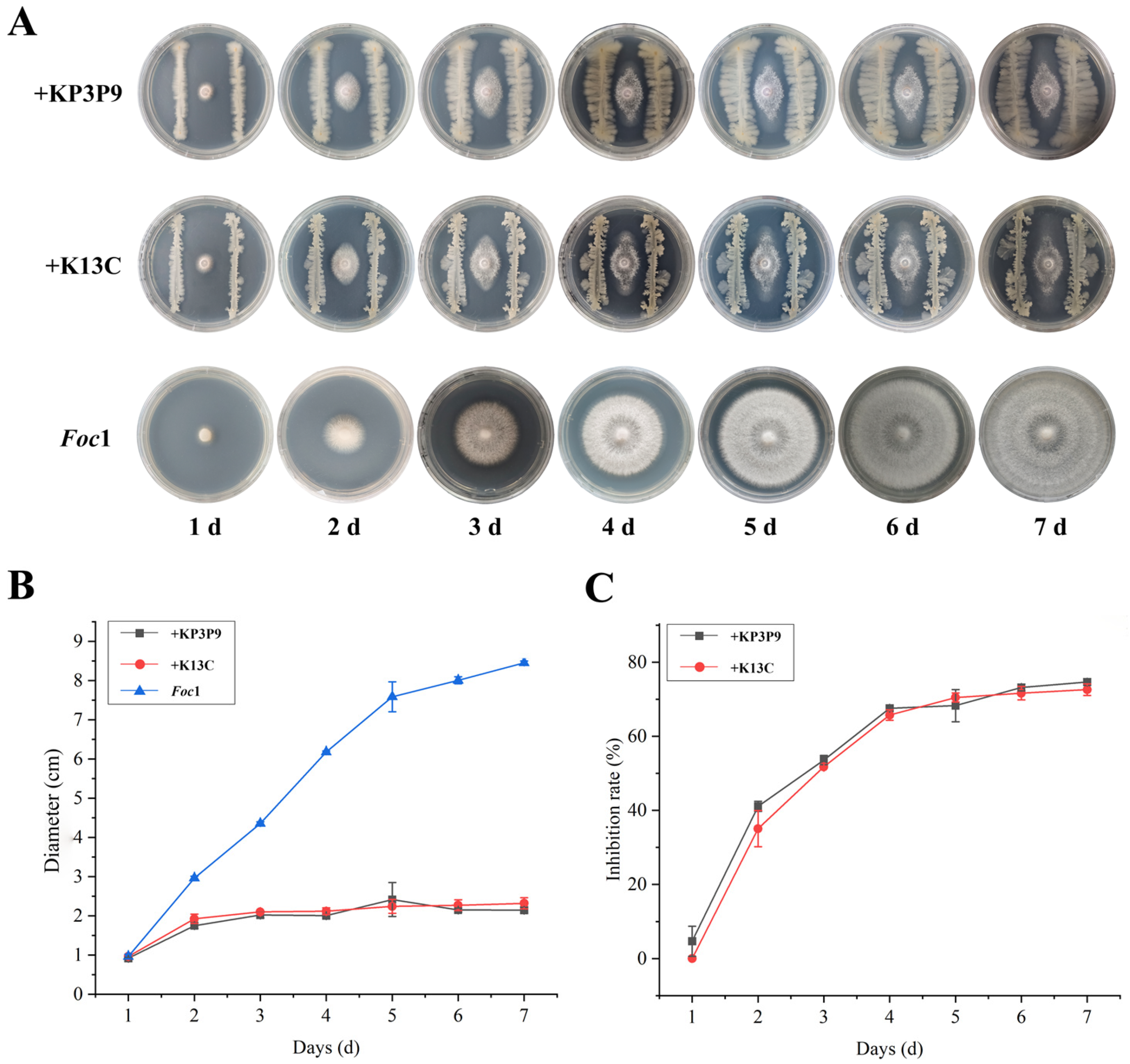
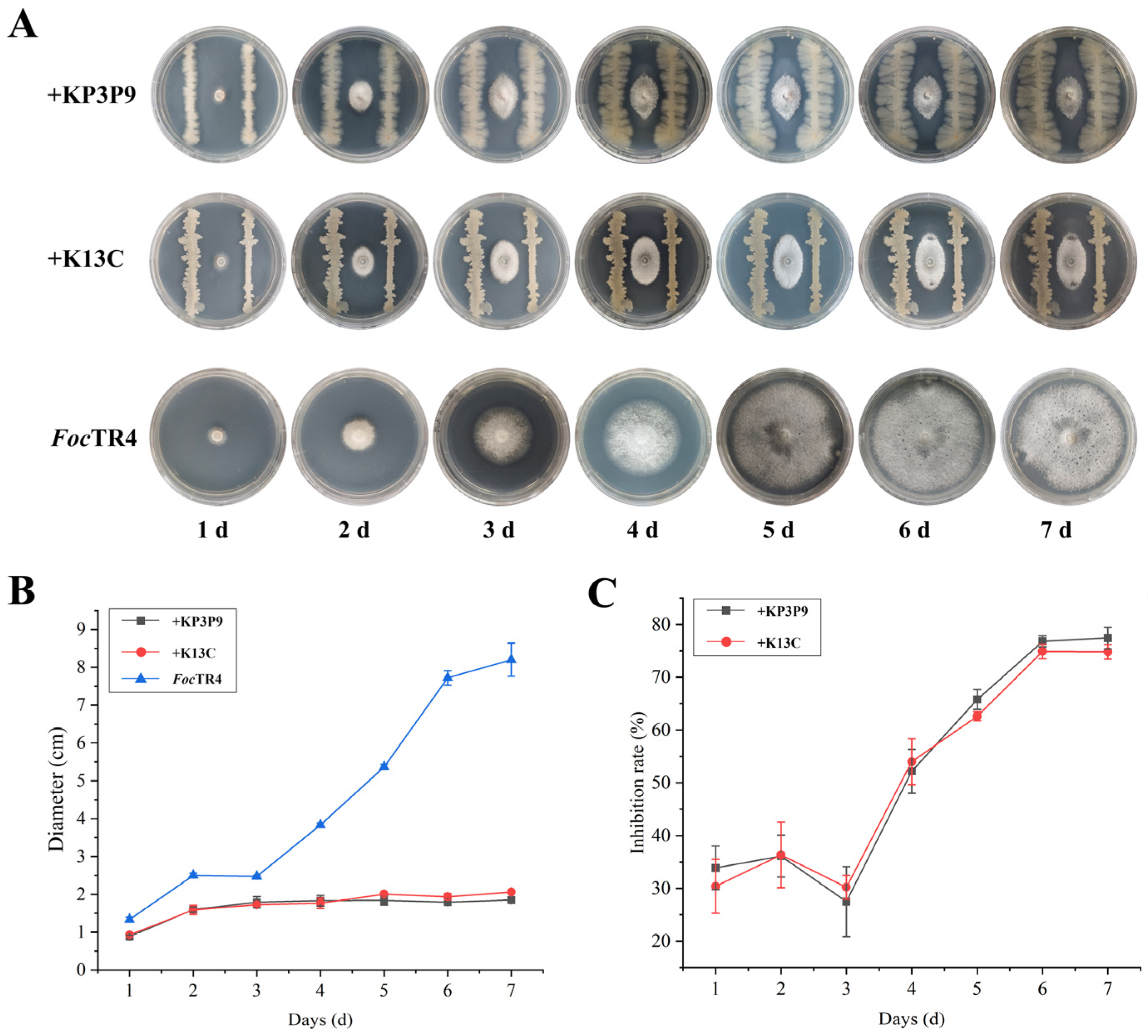
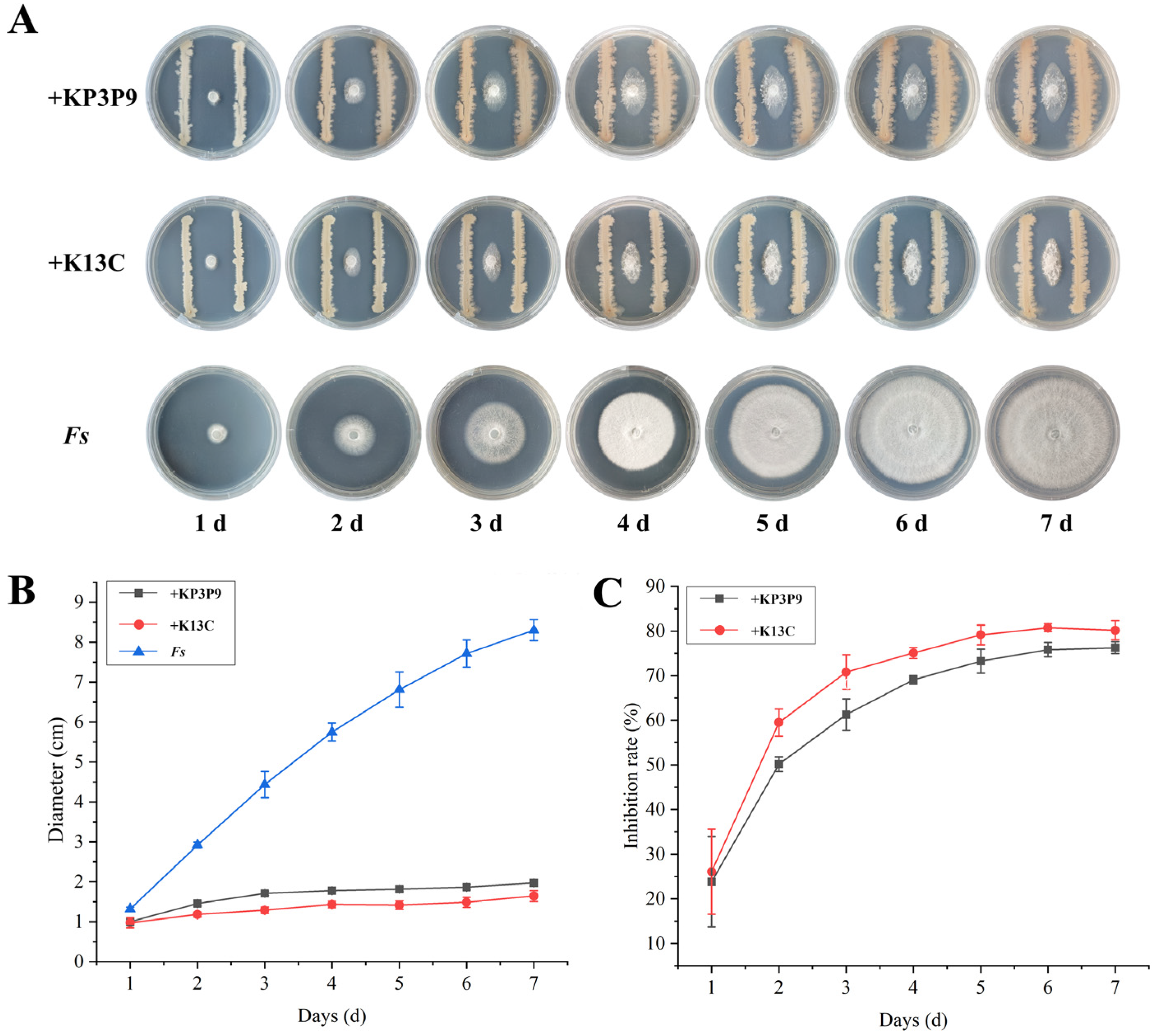
| Parameters | CK | KP3P9 | K13C |
|---|---|---|---|
| Plant height (cm) | 37.92 ± 3.04 b | 46.50 ± 2.32 a | 40.40 ± 4.13 b |
| Stem width (mm) | 2.57 ± 0.32 b | 3.09 ± 0.37 a | 3.12 ± 0.22 a |
| Above-ground part fresh weight (g) | 1.67 ± 0.35 b | 2.59 ± 0.32 a | 2.02 ± 0.29 b |
| Under-ground part fresh weight (g) | 1.18 ± 0.15 b | 1.14 ± 0.03 b | 1.36 ± 0.04 a |
| Plant fresh weight (g) | 2.85 ± 0.36 b | 3.73 ± 0.33 a | 3.39 ± 0.31 ab |
| Total root length | 648.93 ± 72.70 a | 743.72 ± 59.25 a | 745.23 ± 55.46 a |
| Root diameter (mm) | 0.23 ± 0.10 a | 0.29 ± 0.04 a | 0.30 ± 0.04 a |
| Root volume (mm3) | 205.82 ± 116.00 a | 240.91 ± 79.25 a | 253.12 ± 62.50 a |
| Root surface area (mm2) | 474.62 ± 261.27 a | 676.10 ± 110.01 a | 697.62 ± 95.89 a |
| Root projected area (mm2) | 151.08 ± 83.17 a | 215.21 ± 35.02 a | 222.06 ± 30.53 a |
| Root tip number | 398.25 ± 80.74 a | 462.80 ± 40.42 a | 471.80 ± 61.35 a |
| Feature | KP3P9 | K13C |
|---|---|---|
| Chromosome | Chromosome | |
| Genome topology | circular | circular |
| Assembly size (bp) | 4,279,804 | 4,066,559 |
| G + C content (%) | 43.57 | 43.8 |
| Protein coding genes | 3.99 | 4,540 |
| tRNA genes | 97 | 86 |
| rRNA genes | 30 | 27 |
| Prophage | 4 | 4 |
| Gene islands | 6 | 6 |
| CRISPR | 4 | 5 |
| Biosynthetic gene clusters | 14 | 14 |
| GenBank accession ID | JBQIBB000000000 | JBQIBC000000000 |
| Strain Name | Cluster | Length/bp | Known Cluster | Species with Known Clusters | Similarity (%) |
|---|---|---|---|---|---|
| KP3P9 | Cluster1 | 22,953 | Sporulation killing factor | Bacillus subtilis subsp. subtilis str. 168 | 100 |
| Cluster2 | 65,391 | Surfactin | Bacillus velezensis FZB42 | 82 | |
| Cluster3 | 20,803 | - | - | - | |
| Cluster4 | 114,758 | Bacillaene | Bacillus velezensis FZB42 | 100 | |
| Cluster5 | 77,759 | Fengycin | Bacillus velezensis FZB42 | 100 | |
| Cluster6 | 21,898 | - | - | - | |
| Cluster7 | 20,170 | Sublancin 168 | Bacillus subtilis subsp. subtilis str. 168 | 100 | |
| Cluster8 | 41,097 | 1-carbapen-2-em-3-carboxylic acid | Pectobacterium carotovorum | 16 | |
| Cluster9 | 51,777 | Bacillibactin | Bacillus subtilis subsp. subtilis str. 168 | 100 | |
| Cluster10 | 20,746 | Pulcherriminic acid | Bacillus subtilis subsp. subtilis str. 168 | 100 | |
| Cluster11 | 21,611 | Subtilosin A | Bacillus subtilis subsp. spizizenii ATCC 6633 | 100 | |
| Cluster12 | 41,418 | Bacilysin | Bacillus velezensis FZB42 | 100 | |
| Cluster13 | 20,269 | - | - | - | |
| Cluster14 | 21,698 | Thailanstatin A | Burkholderia thailandensis | 10 | |
| K13C | Cluster1 | 65,391 | Surfactin | Bacillus velezensis FZB42 | 82 |
| Cluster2 | 20,803 | - | - | - | |
| Cluster3 | 26,295 | - | - | - | |
| Cluster4 | 114,749 | Bacillaene | Bacillus velezensis FZB42 | 100 | |
| Cluster5 | 77,762 | Fengycin | Bacillus velezensis FZB42 | 100 | |
| Cluster6 | 21,898 | - | - | - | |
| Cluster7 | 41,097 | 1-carbapen-2-em-3-carboxylic acid | Pectobacterium carotovorum | 16 | |
| Cluster8 | 51,777 | Bacillibactin | Bacillus subtilis subsp. subtilis str. 168 | 100 | |
| Cluster9 | 26,225 | Subtilin | Bacillus subtilis subsp. spizizenii ATCC 6633 | 100 | |
| Cluster10 | 20,746 | Pulcherriminic acid | Bacillus subtilis subsp. subtilis str. 168 | 100 | |
| Cluster11 | 21,611 | Subtilosin A | Bacillus subtilis subsp. spizizenii ATCC 6633 | 100 | |
| Cluster12 | 41,418 | Bacilysin | Bacillus velezensis FZB42 | 100 | |
| Cluster13 | 12,731 | - | - | - | |
| Cluster14 | 21,698 | Thailanstatin A | Burkholderia thailandensis | 10 |
Disclaimer/Publisher’s Note: The statements, opinions and data contained in all publications are solely those of the individual author(s) and contributor(s) and not of MDPI and/or the editor(s). MDPI and/or the editor(s) disclaim responsibility for any injury to people or property resulting from any ideas, methods, instructions or products referred to in the content. |
© 2025 by the authors. Licensee MDPI, Basel, Switzerland. This article is an open access article distributed under the terms and conditions of the Creative Commons Attribution (CC BY) license (https://creativecommons.org/licenses/by/4.0/).
Share and Cite
Feng, Z.; Qin, M.; Ma, X.; Feng, R.; Zhao, H.; Meng, Y.; Cheng, C. Characterization of Two Potential Biocontrol Bacillus Strains Against Maize Stalk Rot. Microorganisms 2025, 13, 2255. https://doi.org/10.3390/microorganisms13102255
Feng Z, Qin M, Ma X, Feng R, Zhao H, Meng Y, Cheng C. Characterization of Two Potential Biocontrol Bacillus Strains Against Maize Stalk Rot. Microorganisms. 2025; 13(10):2255. https://doi.org/10.3390/microorganisms13102255
Chicago/Turabian StyleFeng, Zhiwei, Mengyao Qin, Xiaobing Ma, Ruiyun Feng, Huifang Zhao, Yingchao Meng, and Chunzhen Cheng. 2025. "Characterization of Two Potential Biocontrol Bacillus Strains Against Maize Stalk Rot" Microorganisms 13, no. 10: 2255. https://doi.org/10.3390/microorganisms13102255
APA StyleFeng, Z., Qin, M., Ma, X., Feng, R., Zhao, H., Meng, Y., & Cheng, C. (2025). Characterization of Two Potential Biocontrol Bacillus Strains Against Maize Stalk Rot. Microorganisms, 13(10), 2255. https://doi.org/10.3390/microorganisms13102255






